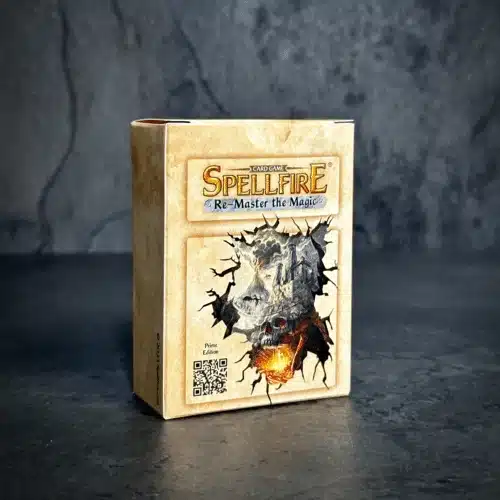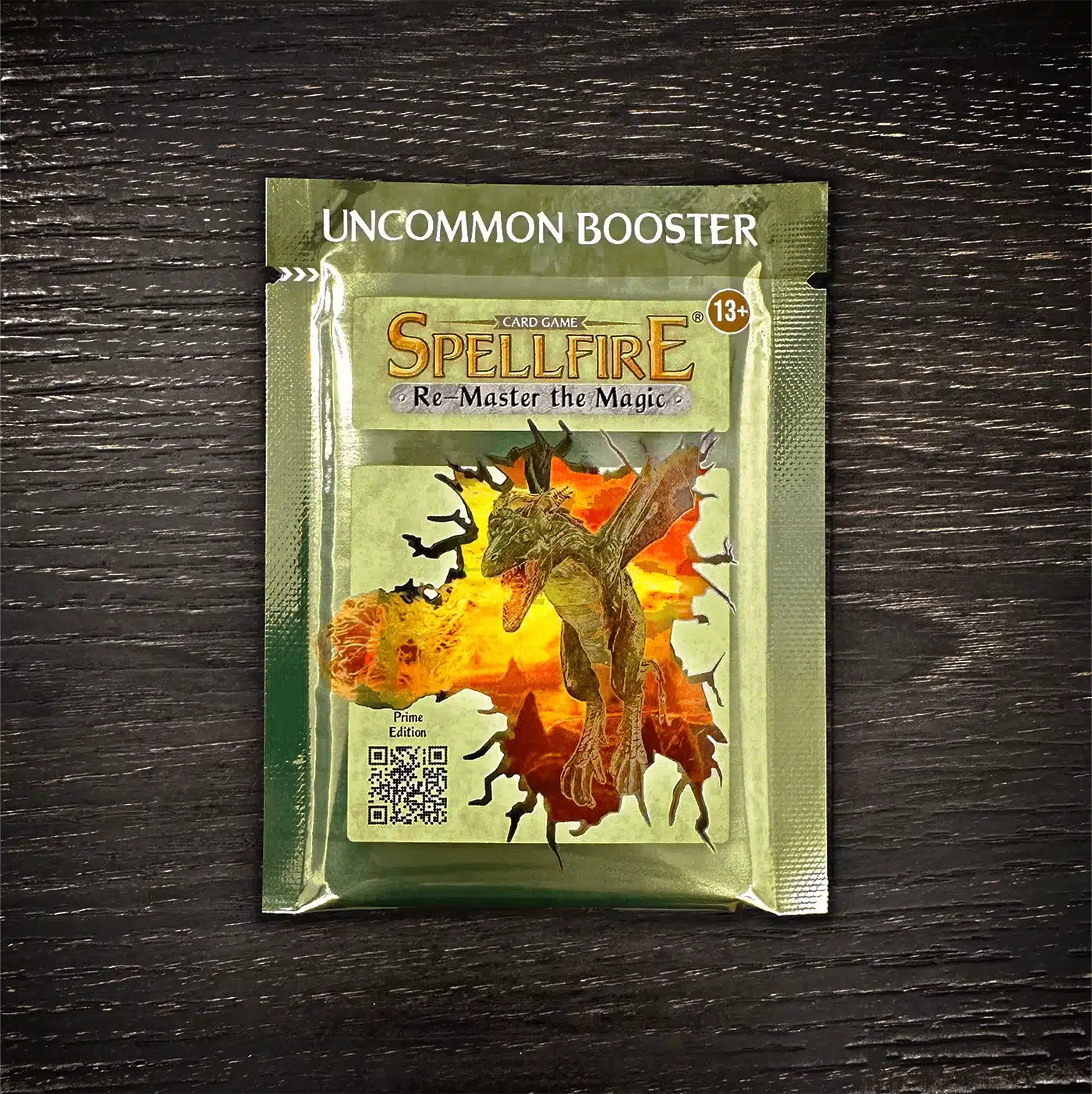The Strategy
Secrets, tips, and tricks to win the gameIndividual card strategies
A guide to decide which cards to choose
Strategy in the Spellfire card game is a crucial part of the game. There are two broad categories here: the style of play and deck-building or deck theme. The two strategies are linked: what theme your deck will be will significantly influence how you play your cards during a game. For instance, having an undead deck, your strategy will revolve around attacking an opponent's realms, as this is where undead decks excel.
In Spellfire, tactics relate to using your cards to accomplish your primary goal. Depending on the cards you currently hold in hand, you may change your game strategy as the game goes on.
Which cards to choose for your deck?
Choosing the cards to go into a deck determines the theme of the deck and your overall success. You may think, what are the factors to consider when choosing cards to put into the deck? Luckily, we are here to answer.
Realms
Spellfire decks should contain a minimum of 10 realms in each 55-card deck. That's the key to staying competitive and having a chance to win. Considering how many cards can be used to destroy or raze realms, having fewer means that you may not be able to win the game at any given time.
Let's say you have 15 realms in a deck. That means that there's a good chance you'll draw a realm every third or fourth card, and it increases your odds of completing six realms first. Note, that the average deck consists of 12 realms. Three cards are available to follow the theme of the deck or to increase the number of holdings that can be used.
So, which realms are best for decks, you might wonder? It depends on many things but most importantly on these factors:
1) the theme of the deck,
2) the special power of the realm, and
3) the realms the player has access to.
As previously mentioned, Spellfire decks must adhere to a theme. Also, the types of realms used are essential. If a deck has a theme of Frozen Fire, realms from that world should be used to take advantage of the optional World Bonus rule. Other realms offer benefits to other realms within the same world as well. With realms of one world, putting holdings into play is much easier.
However, the non-world theme is equally popular. It is possible, for instance, to find realms that are beneficial to defending heroes in practically any world. A player must search through all of his realms and choose powers that best fit the theme.
Many players choose realms solely for their special powers or just personal liking of the cards. Flyer and swimmer-only realms and others with similar restrictions on the type of champions that can attack are incredibly popular. Players can also benefit from special powers within certain realms that help them attack better.
Last but not least, you don't have to pay the money to order an unlimited quantity of Spellfire cards. This means you must weigh the advantages and disadvantages of each realm available to you specifically. There is no rule that all realms must be rare or untouchable, and Holdings may also be used to enhance a realm's playability.
Holdings
Holdings are important but often overlooked. Since a standard deck of cards is limited to 55 cards, players tend to find better uses than holdings. However, holdings do have special powers that can be helpful regardless of the number of cards used in a deck. Choosing which holdings to use depends on the theme of the deck.
Typically, Spellfire decks with a world theme have the most holdings since they must be linked to the same realm. Nevertheless, several holdings can be attached to any realm, and they are extremely popular in decks with a mix of realms from different worlds.
Finally, bear in mind that the special powers of holdings can be as powerful, or even more powerful, than the realms to which they are attached. Having certain realms and holdings can make a realm invulnerable to attacks or very difficult to defeat. Always keep holdings in mind when creating any Spellfire deck.
Champions
Speaking of champions, for each deck, they are chosen based on the deck's theme too. The number of champions and their levels should also be considered not to exceed the Deck Construction Limits.
A deck built around a theme will depend heavily on the champions used. Champions from the corresponding world should be included in most world-themed decks. The presence of one or two champions who fit in with a sub-theme is good, but too many champions may conflict with rules like attaching artifacts or using the optional World Bonus rule.
Spellfire decks rely on champions' special powers, often becoming the player's primary focus. It is possible to win or lose a game based on the strength of your champions with potent special attacks. Depending on the options available to you and what theme (if any) you are playing, you should make these decisions individually.
A 55-card deck can only accumulate 90 points of champions, so you need to choose them with care. You should have 11 to 14 champions in a deck with an average level of 5 to 7. To use avatars, you're likely to choose a few low-level champions.
Rule Cards
Putting Rule Cards into play adds an unusual twist to gameplay. The rule cards aren't required but can help with different themes. It is recommended to have a minimum of two in your dec: even when you do not win the game with one rule card, you can remove another one that is helping your opponent.
The choice of rule cards depends on the deck's theme. Rules that eliminate spells or hinder them are recommended if you don't intend to use spells in your deck. This also applies to any other theme deck, and remember that rules cards can add more appeal to a deck.
Also, note that rule cards affect everyone. If you don't know what cards your opponent will play, the rule card may also benefit him or harm you.
Events
A deck's specific theme determines the types of events it should contain, so be aware. Due to the number and potential power of event cards, it's recommended to have 8 to 10 events per deck. A deck can be built around a few important events for its theme. On the other hand, many others can come together well with the theme. It would be best to choose which events to include in your deck based on the other cards you have. In the end, you can put whatever events you like. However, using them to advance a theme can lead to a swift victory.
Artifacts
While Spellfire artifact cards can be powerful, using them correctly means thinking about several factors. For one thing, they are usually attached only to champions of the same world. It is vital to have many champions from the specific world if you wish to use artifacts, and in some instances, that won't be the best strategy.
Note that artifacts are subject to the Rule of the Cosmos in addition to realms, holdings, and champions. Your artifact stays in your hands the whole game if the opponent gets the same artifact into play first. In addition, artifacts often get overshadowed by magical items because they are easier to use.
Consider Artifacts when selecting a theme deck, especially a world theme. Due to most champions in world-themed decks coming from the same world, it is relatively straightforward to get an artifact into play. Many champions are immune to offensive magical items, but only a few are immune to the special powers of artifacts.
Magical Items
The most popular Spellfire cards to attach to champions are magical items, as they provide an incredible range of special powers. Magical items, unlike spells and allies, remain with the champion. Spellfire has many cards that can negate, remove or discard magical items, which causes them to lose their usefulness.
In most cases, this applies only to offensive magical items that influence the opposing champion. Cards that are immune to defensive magical items can only ignore the item's level bonus (if any), but not its special power.
In deciding which magical items to include in a deck, consider their special powers and level bonuses. Considering these factors, you must select the magical item that fits the theme of your deck. Usually, decks based around battle contain magical items with high-level bonuses or ones that confer special abilities like Earthwalking or flying.
Spells
Spells are always considered when constructing a Spellfire deck due to their potential power. A deck that uses spells must first contain champions capable of casting them and have a theme that fits spells. The versatility of spells, which can be used throughout a turn, makes them comparable with events. Spells with higher-level bonuses and more offensively themed special powers tend to be more combat-focused than others.
Noncombat spells usually have more than one usage in the game. For a deck that focuses on spellcasting, spells are obvious. The spells need to support their sub-theme, not restrict it to one area of the game. In combat decks, phase 4 spells are more prevalent than phase 3 spells, but phase 3 spells are still important.
If there are no spellcasters in your pool, spell cards must remain in your hand. Most champions, however, can acquire the special power to use spells through realms, holdings, and magical items. When choosing spell deck support cards, you should keep this in mind.
Allies
In combat, allies can be paired with almost any champion. A deck's theme generally determines which allies are included, if any. Consider both the allies' special powers and their level bonus when choosing. Most skills center on one of these fields, while some are strong in both. Flying allies should feature in decks with a theme based around flyers, or at least allies with special powers like reaching realms, not in front of formations.
Allies with special powers can easily win a battle round regardless of the level. These allies are called instant defeat allies. Although these cards are great choices for any deck, until an opponent plays a card that can affect them, their usefulness is limited solely to their level bonus. In Spellfire, allies are subject to special powers explicitly designed to target them. Many cards cause allies to be discarded during combat, and any deck containing allies should be cautious of these cards.
There is also a category of allies known as "vengeful." These allies have special powers designed to harm an opponent's forces-or, the opponent himself. For these allies to activate their power, the attached champion has to lose a battle round. Yet, there is a con here: a strategy based on these allies has the drawback of costing a champion to deploy. Are the results worth it? It's up to you to decide.
Other Card Types
Using psionic power cards, unarmed combat cards, blood ability cards, or thief skills depends heavily on the deck's theme. Unarmed combat cards are recommended for those who prefer a hero theme, while blood ability cards can only be used with regent champions; the same goes for other card types. These cards can be helpful in any deck, but overall, the choices are always up to you.


